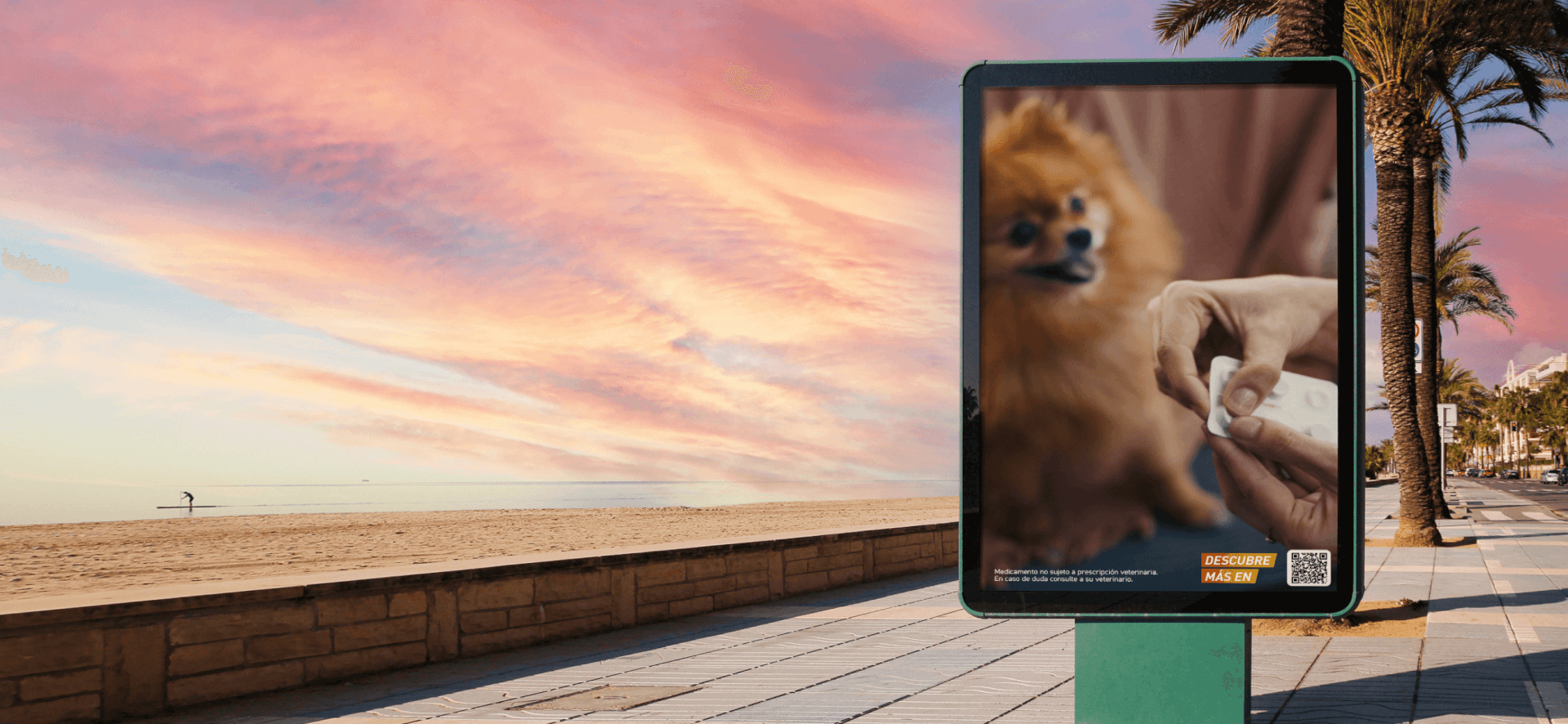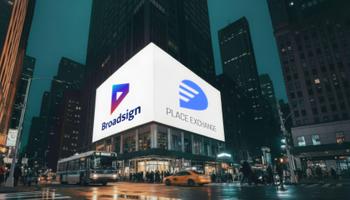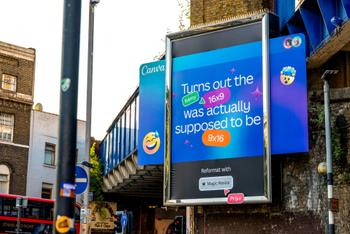As of early 2025, consumers were spending over $555 billion each month on retail, but only 18.9% of that happened online. Despite ongoing digital growth, 45% of shoppers still prefer brick-and-mortar stores as their primary channel, and 72% visit physical locations weekly, according to Capital One Shopping.
These habits reflect a fluid decision-making process. With 82% of purchases made in-store—and 62% driven by impulse—advertisers have a powerful opportunity to influence shoppers at the point of decision.
Digital out-of-home (DOOH) advertising is key to capturing that moment. It grabs attention, builds awareness, and connects online engagement to in-store action, creating a more seamless and impactful customer journey.
Turning retail challenges into opportunities with DOOH
Retail is evolving fast, with fragmented journeys, higher shopper expectations, and growing pressure to turn online engagement into store traffic. Traditional digital ads often miss the mark—skipped, blocked, or ignored at key moments.
Digital OOH offers a powerful alternative, reaching consumers during daily routines like commuting, shopping, or socializing. These unavoidable brand moments drive both awareness and action. According to OAAA and Morning Consult, 42% of consumers say OOH ads impact their in-person shopping decisions, and once inside a store, 75% still notice those ads. Meanwhile, a global study reveals 56% of shoppers purchased an item featured in a DOOH display, with most of those purchases (65%) being unplanned.
As brands adapt to shifting consumer habits, OOH bridges the gap between online and offline, delivering meaningful, measurable results right where buying decisions happen. Here’s how to make it work.
Drive foot traffic to purchase locations
As digital noise intensifies, brands are turning to OOH to drive real-world results. It’s a high-impact, last-mile tool that reaches consumers at key moments with location-relevant prompts. In fact, research from Talon Outdoor shows 59% of shoppers are likely to buy within 30 minutes of seeing an OOH ad, highlighting its power as a last-mile driver.
Smart OOH strategies leverage proximity, timing, and context to turn awareness into action. For instance, proximity-based targeting helps reduce friction along the path-to-purchase by delivering messages when and where shoppers are ready to act, whether that’s during a commute, while running errands, or browsing in a high-traffic retail zone.
To maximize impact, marketers can:
- Appeal to price-sensitive consumers by highlighting promotions, limited-time deals, or exclusive in-store offers. With 41% of shoppers willing to switch stores or brands to save money, these cues can be powerful motivators.
- Use high-visibility screens in key pedestrian zones (like digital billboards and urban panels) to build upper-funnel brand awareness and capture attention early in the customer journey.
- Incorporate interactive or time-sensitive messaging in long-dwell environments, like transit hubs where people spend between 5-15 minutes on average, offices, and casual dining venues. These venues are ideal for more detailed storytelling or promotional offers.
- Drive urgency with last-mile tactics by promoting local store locations, curbside pickup options, or real-time stock availability, prompting immediate visits.
- Align messaging with seasonal moments, like back-to-school or the holidays, when audiences are already in a buying mindset.
Success story: Holt Renfrew’s strategic DOOH campaign
Holt Renfrew, Canada’s largest fashion and lifestyle retailer, offers a strong example of strategic digital OOH execution. When Nordstrom exited the Canadian market, Holt Renfrew moved quickly to capture market share among key demographics.
Leveraging geofencing to target areas surrounding closing Nordstrom locations, the campaign activated ads across high-traffic formats like billboards, bus shelters, and urban office buildings within close reach of its core audience. In total, 200 ads ran across seven Holt Renfrew markets, including residential neighbourhoods strategically selected through consumer mapping. Over ten weeks, the campaign drove more than 400,000 store visits, showcasing how smart placement, audience insights, and well-timed messaging can deliver real-world results.
Integrate online and offline journeys
Boosting online sales and engagement starts with smarter, more personalized OOH. By leveraging first-party data, like loyalty program activity or past purchase behaviour, brands can deliver targeted creative that speaks directly to individual shoppers. Interactive elements like QR codes, touchscreens, or social media prompts embedded in DOOH campaigns make those messages instantly actionable.
Viewers can scan a QR code with their phone, triggering an immediate redirect to a microsite, product page, or mobile wallet offer. Saved deals can then prompt timely reminders based on location or expiration, keeping the brand top of mind. Every interaction—from the scan itself to timing and location—is tracked and analyzed, turning passive impressions into valuable insights.
This closed-loop approach bridges physical and digital touchpoints while enabling continuous optimization. And with 76% of consumers taking mobile action after seeing a digital OOH ad, the opportunity for meaningful engagement—and measurable results—has never been greater. From website visits and app downloads to conversions and social shares, interactive DOOH empowers brands to connect, convert, and learn in real time.

Target the right audience with smarter segmentation
Not every shopper engages with the same message or environment. Luxury buyers, for instance, respond to exclusivity and aspirational messaging. Target them in premium urban areas with sleek visuals, minimal copy, and high-end lifestyle cues. Digital billboards and urban panels near luxury retailers or in high-income neighbourhoods help reinforce brand prestige. Value-driven shoppers, on the other hand, are motivated by savings and practicality.
To maximize OOH impact, brands must tailor their creative and placement to their audience and context Some examples include:
- Bargain Shoppers (ages 55–64) and Department Store Shoppers (primarily women in the same age group) are often found browsing malls and retail corridors in search of deals. Use OOH screens in malls, transit stations, and shopping areas to promote limited-time offers or loyalty incentives.
- Daily Deal Consumers, who span all age groups and skew female, respond well to time-sensitive promotions. Highlight coupon codes, mobile savings, or QR-driven discounts using interactive formats in long-dwell venues like casual dining spots, grocery stores, or point-of-care locations.
- Holiday Shoppers, who emerge seasonally and lean slightly female, are driven by urgency and convenience. In the lead-up to peak retail periods, focus OOH messaging on gift guides, holiday exclusives, and extended store hours.
- Gen Z and Millennials are drawn to bold visuals, interactivity, and values-driven messaging. Use QR codes or social prompts to drive mobile engagement and connect them to exclusive content or offers. Prioritize placements in transit hubs, urban panels, and social venues, with messaging tied to causes like sustainability or inclusivity.
Measure success and optimize campaigns
With DOOH, retail marketers can go beyond basic awareness metrics to track high-value actions—like in-store visits, footfall traffic, online purchases, and app interactions—offering a clearer view of how OOH drives shopper behaviour from discovery to conversion. Attribution connects these insights to broader media performance, revealing how OOH works alongside digital, social, and in-store efforts to boost engagement and sales.
Modern OOH campaigns come equipped with robust measurement tools, including:
- Mobile location data: Understand how shoppers engage with OOH ads and whether they visit a store or interact online afterward.
- Footfall analysis: Measure physical store traffic tied directly to campaign exposure.
- Sales lift studies: Track the revenue impact of targeted OOH campaigns across specific products or categories.
- Brand lift studies: Assess how OOH influences brand recall, purchase intent, and favorability during key shopping moments.
The future of retail isn’t purely digital or physical—it’s a blend of both. Out-of-home advertising connects these worlds, guiding shoppers from screens to storefronts with relevance, impact, and intent. By combining smart targeting, engaging creative, and measurable outcomes, OOH turns moments of attention into moments of action—bridging the gap between awareness and conversion in a way few other channels can.







